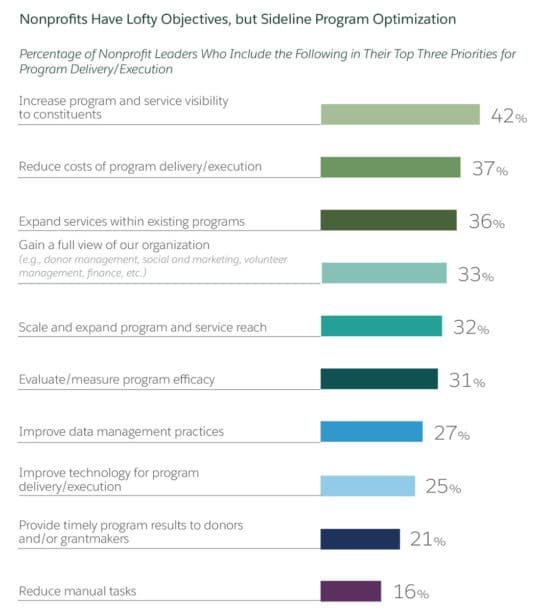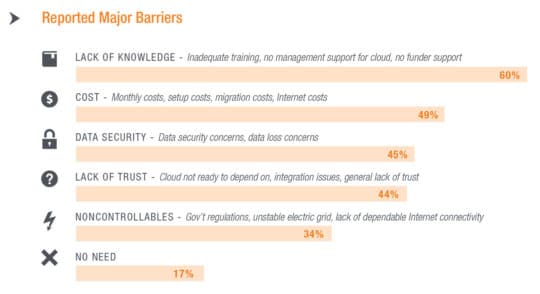So I was researching the role of technology in the nonprofit industry when I came across this article from Yale Insights that suggested that only 11 percent of nonprofit leaders considered their organization’s approaches to technology as highly effective. I can’t really say that I was surprised to find this result; by the end of this article, you’ll know why.
What struck me the most was the answer given by a nonprofit leader. He was interviewed by Yale Insights journalists in the article. When asked about the reason why technology should be an area of focus for nonprofit organizations, he said the following:
“We know nonprofit leaders and staffs want to adopt technology; that’s the good news. The bad news is, few integrate technology into their organizational strategy. Worse yet, they know this growing performance gap is limiting their organizational mission and fundraising potential.”
So why are leaders still hesitant about integrating technology into their organizational strategy?
As it turns out, to really understand the state of tech adoption in the nonprofit industry as well as barriers that prevent a wide adoption, one needs to dig deep.
Recommended for you: The Positive and Negative Influence of Technology on Kids.
The State of Technology Adoption in the Nonprofit Sector
It goes without saying that the nonprofit branch can benefit from using technology in a profound way. However, the facts provided by sources like the abovementioned Yale Insights article suggest that the sector is moving very slowly in the direction of tech adoption.
So, if the technology is not on the agenda, what are the priorities of nonprofits in the upcoming years?
Let’s throw some more figures here. According to the recent Nonprofit Trends Report, nonprofit leaders are more concerned with increasing program and service visibility (42 percent), reducing costs of program execution (37 percent), and expanding services within existing programs (36 percent).
Credit: Nonprofit Trends Report.
Don’t get me wrong, most of the top goals, apparently, are very important, too. What I’m really trying to say here that it’s clear that the tool that can help with achieving them – technology – is still widely unseen as a legitimate part of organizational strategy.
Tim Savage, a nonprofit writer from the review service Best Writers Online, agrees.
“This is a very surprising finding considering the fact that many nonprofits are severely limited in their abilities because of the lack of utilization of digital platforms and tools,” he shares.
In fact, Nonprofit Trends Report also found that the organizations in the sector are, and I quote,
“burdened by manual measurement and reporting.”
In addition to these findings, I found that many organizations leave some major opportunities for advancement even after implementing a digital platform or a tool. For example, a report called Cloud Technology for Nonprofits found that the organizations that managed to incorporate cloud solutions often cannot expand the use of this technology beyond basic features as email and file storage.
Clearly, some major mindset change is needed to improve the reach of nonprofits and make them more effective.
Barriers to Overcome
We’ve already touched down on some of the barriers to technology adoption voiced by nonprofit leaders, but to fully understand what keeps them from advancing their organizations through the use of digital tools, we need to take a look at this.
The following is a list of reasons for the slow adoption of digital tools and platforms in the industry, with a particular focus on cloud solutions.
Credit: Cloud Technology for Nonprofits.
While most of these problems can be solved with increased funding, some require solutions like education. For example, some decision-makers may really lack knowledge of the benefits of using digital tools and platforms to achieve the goals of their organizations, so conveying this information to them should become a major task.
To complete this task successfully, performing a detailed cost analysis, reading case studies, and getting information on specific, tangible benefits of particular digital platforms for nonprofits should be enough to eliminate such issues as a lack of knowledge, data security concerns, and, quite possibly, a lack of trust in new technologies.
For example, here’s a great article on this blog busting four common myths about clouds such as poor security and high costs for you to start.
You may like: 4 Ways Digital Technology Revolutionized Modern Logistics Operations.
Hope for Change

Clearly, nonprofits need to adopt digital solutions to be able to achieve their goals more effectively and efficiently. While the above findings are not particularly promising, there are some predictions suggesting that the branch is on the verge of a massive change. For example, the abovementioned Nonprofits Trends Report states that even though 5 percent of nonprofits have AI capabilities, the prevalence of this technology is projected to increase by 361 percent over the next two years (!).
Hopefully, more and more organizations will become more aware of the benefits of using tech to advance their operations, and by the next time someone conducts research on that, the figures will be much more different.
Nonprofit Technology Resources to Check Out Online

While we are waiting for the conditions for nonprofit organizations to become better and technologies become more accessible, there are some online resources that can help nonprofit leaders to advance their knowledge about the nonprofit world and how they can come closer to using advanced technologies in their organizations. Here are some notable examples to check out:
Neon One

Basically, Neon One is a suite of tools that every nonprofit should have. Its mission is to become the most comprehensive technology ecosystem for nonprofits, but there is much more to it than just its values. Neon One consists of such features as a CRM platform, client and case management software, fundraising tools, and so much more. All of these, of course, is specifically tailored to meet the needs of nonprofit organizations. It’s perfect for managing your data no matter how large it may be.
TED

TED is the short form of “Technology, Entertainment, Design” which is pretty much everything TED is about. It aims to eliminate the gap between new products and ideas and those they are most valuable for. Moreover, these products or ideas can come from all kinds of industries including the arts, business, science, technology, and social issues. TED provides leaders from different organizations to express their views, expert opinions, and groundbreaking ideas which can give your nonprofit a new opportunity to expand.
TechSoup

If you are thinking about a place where to start your search for new technologies, TechSoup is what you want to check first. This is where nonprofit organizations can research and find technology products and services with discounted or lower prices that will be more affordable for them. The team behind TechSoup is committed to building a community where values such as transparency and mobilization through technology are the foundation for everything else.
NPR

One could say that NPR is somewhat similar to TED and they wouldn’t be wrong. However, while TED aims to spread ideas, NPR spreads the news. NPR is a multimedia provider that delivers high-quality relevant information, news, and music programming to over 975 different stations. Their podcasts and newscasts have millions of listeners who tune in to hear insights on global events, cultures, and ideas. Their stations are perfect for nonprofit organizations to be up-to-date and get to hear about all the opportunities they have to promote themselves.
Box.org

Box.org is perfect for secure cloud content management. This collaborative platform is already used by thousands of foundations and nonprofit organizations, so it is only logical for you to join in. You will be able to use their file storage option as well as enjoy various other features regularly added to the platform. Data security is becoming a top priority for many businesses, so it is essential to find the best solution for your organization.
Donorbox

Donorbox is one of the most powerful fundraising software for nonprofit organizations. From the time of its release, Donorbox’s platform has been widely adopted by many nonprofits around the globe. The main features of this platform are goal meter, recurring donations, post updates to subscribers, donor wall, processing fee covering option, etc. Donorbox offer supports for greater than eleven languages. It helps any nonprofit organization to easily build their own crowdfunding pages in their local language. Along with that, the crowdfunding software of Donorbox has the most inexpensive pricing model in the fundraising service. They charge only a 1.5% fee for using their platform. Along with this fee, you also need to include the payment processing fees. The payment processing fees vastly depend on the payment gateway- ACH bank transfers, PayPal, or Stripe.
SamaSource

If your organization is somehow connected to young people and women in poverty, you might want to work with SamaSource. SamaSource is giving impoverished youth and women the opportunity to engage in digital work. They provide basic computer skill training before up their workers with clients who require such remote workers. Their impact sourcing strategy is already being acknowledged as one of the best strategies to use when you have such a nonprofit organization like theirs.
You may also like: Top 10 Healthcare Technology Innovations We Have Witnessed!
Fluxx Grantseeker

Fluxx Grantseeker does what is mentioned in its name: it helps with grants. Most nonprofit organizations either already have an established grant program or need to get one to be able to supplement the funding they receive from various other sources. Fluxx Grantseeker enables you to manage your grant program from the beginning to the very end by tracking grant funder information, project deadlines, payments, impact reports, and so on.
Ushahidi

Last but not least, Ushahidi aims to give voices to those who are not heard. Ushahidi is a nonprofit organization that develops open-source and free software for collecting information, interactive mapping, and visualization. So far, 35,000 crisis maps have been in over 30 different languages in over 159 countries. It is now used to organize emergency responses for those in crisis or experiencing violence in some way.
This article is written by Gregory V. Chapman. Gregory is passionate about researching new technologies in both mobile, web, and WordPress. Also, he works on Best Writers Online the best writing services reviews. Gregory in love with stories and facts, so Gregory always tries to get the best of both worlds.







